30+ Remote work tools that companies should use in 2024

Remember that iconic scene from the movie "Forrest Gump" where Forrest says, "Life is like a box of chocolates; you never know what you're gonna get"? Well, that phrase might as well apply to how our work lives have evolved over the past few years.
Who would've thought that a global pandemic would turn our work routines upside down and lead to the meteoric rise of remote work?
If you're like most of us, you've had to adjust to a new normal, trading your daily commute for Zoom meetings and your office chair for the comfort of your own couch.
But, as we all know, every silver screen has its supporting cast, and in the world of remote work, those unsung heroes are the remote work tools.
So, what exactly are remote work tools, and how did they come to play such a vital role in our professional lives? Let's dive into the nitty-gritty details and explore this fascinating transformation!
What are remote work tools?

Are you one of those people who've recently found themselves working from home, pajama-clad with a cup of coffee in hand, wondering, "What are these remote work tools everyone's talking about?" Well, you're in the right place, because we're about to dive into the fascinating world of remote work tools.
Remote work tools are essentially the digital Swiss Army knives that make working from anywhere possible. They're the secret sauce behind the seamless transition from cubicles to couches. Picture this: You're collaborating with colleagues scattered across the globe, and it feels as if you're all in the same room. That's the magic of remote work tools!
At their core, these tools are designed to facilitate communication, collaboration, and productivity when you're not physically in the same office space. They include platforms like Zoom and Microsoft Teams for virtual meetings, Slack for instant messaging, and project management tools like Trello or Asana to keep everyone on the same page.
Document sharing and storage tools like Google Drive make it easy to access and collaborate on files from anywhere. And when it comes to keeping your tasks organized, tools like Todoist or Monday.com have got your back.
Setting the stage for remote work

"Are you tired of long commutes, office politics, and the rigid 9-to-5 grind? Well, you're not alone. The world has seen a seismic shift in the way we work, and it all starts with setting the stage for remote work. But what exactly does that mean?"
Let's break it down for you:
- The rise of remote work: The remote work revolution didn't happen overnight. It gradually gained momentum over the years, with technology paving the way. However, it was the COVID-19 pandemic that gave it the spotlight. When offices closed, millions of employees worldwide set up their home offices.
- A New work-home blend: Remote work isn't just about working from home; it's about finding the perfect blend of work and personal life. People now have the flexibility to choose where they work, be it from a cozy home office or a trendy cafe.
- Tech tools and platforms: The key to successful remote work lies in technology. Companies have invested in digital tools, communication platforms, and project management software to ensure that teams can collaborate seamlessly, regardless of their physical location.
- Changing company cultures: Remote work has challenged traditional company cultures. Organizations had to pivot to trust-based work environments, focusing on results rather than hours clocked in the office.
- Impact on well-being: Remote work has both its perks and pitfalls. While it offers flexibility, it can also blur the lines between work and personal life. Setting boundaries and maintaining work-life balance have become crucial.
- Global talent pool: Remote work has shattered geographical boundaries. Companies can now tap into a global talent pool, potentially finding the best fit for their teams worldwide.
- The future of work: Setting the stage for remote work isn't just a temporary shift; it's a glimpse into the future of work. As companies embrace remote and hybrid models, understanding how to thrive in this new landscape is essential.
How to manage remote teams?

The world of work has transformed, and managing remote teams is the new frontier. So, how can you master this art and lead your team to success?
- Effective communication: It all starts with communication. In a virtual world, clear and constant communication is your lifeline. Utilize tools like Slack, Zoom, or Microsoft Teams to keep the lines open, and consider incorporating a background noise removal app during video meetings to ensure clarity and professionalism. Schedule regular video meetings to build rapport and ensure everyone's on the same page.
- Set clear expectations: Remote work thrives on clarity. Define roles, responsibilities, and expectations clearly. Your team should know what's expected of them and how success is measured. Document processes and share them centrally for easy reference.
- Trust and autonomy: Trust is the cornerstone of remote team management. Trust your team to get the job done, and offer them the autonomy to do it their way. Remember, it's about results, not micromanaging.
- Tech toolbox: Equip your team with the right technology. Ensure they have access to the necessary software, hardware, and training. A well-equipped team is a productive team.
- Regular check-ins: Scheduled one-on-one and team check-ins are crucial. They provide a platform for discussing progress, challenges, and offering support. It's also a chance for team members to connect on a personal level.
- Cultural connection: Don't forget about company culture. Nurture it even in a remote setting. Organize virtual team-building activities, celebrate milestones, and create a sense of belonging.
- Flexibility and well-being: Remote work offers flexibility, but it can blur the lines between work and personal life. Encourage your team to set boundaries, take breaks, and prioritize their well-being.
- Feedback and recognition: Offer regular feedback and recognition. Acknowledge your team's efforts and achievements. Positive reinforcement goes a long way in motivating remote employees.
- Continuous learning: Encourage continuous learning and growth. Remote work often involves adapting to new technologies and ways of working. Support your team in staying updated and relevant. Similar to Amazon vendor services and how it supports existing vendors for a strategic long-term relationship.
- Emergency plans: Lastly, have contingency plans for emergencies. Prepare for technical glitches, internet outages, or personal crises that may disrupt work.
What are the benefits of using remote working tools?
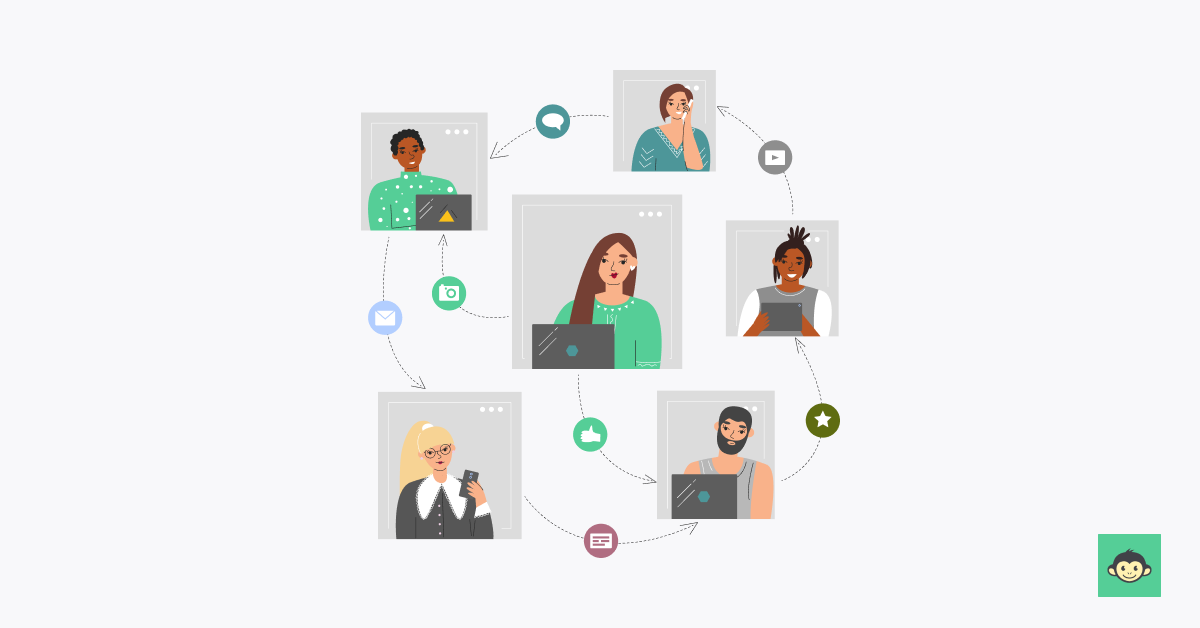
Remote working tools have transformed the way we work, offering a multitude of benefits that enhance our productivity, flexibility, and overall job satisfaction. Let's delve into seven key advantages of using these tools:
Flexibility and location independence
Remote working tools liberate you from the confines of a traditional office. They allow you to work from anywhere, whether it's your cozy home office, a trendy coffee shop, or a beachside paradise. Say goodbye to long commutes and hello to work-life freedom.
Enhanced collaboration
These tools bridge the gap between remote team members. Whether you're in New York or New Delhi, you can collaborate seamlessly. Features like video conferencing, instant messaging, and document sharing ensure your team stays connected.
Increased productivity
Remote working tools streamline tasks and workflows. With project management software, you can track progress, set deadlines, and delegate tasks efficiently. This boosts productivity, allowing you to accomplish more in less time.
Cost savings
No more spending on office rent, utilities, or commuting expenses. Remote work tools significantly reduce overhead costs for businesses. It's a win-win for both employers and employees.
Talent pool expansion
When your workforce isn't bound by location, you can tap into a global talent pool. This means access to a diverse range of skills and perspectives, helping your company thrive in a competitive landscape.
Work-life balance
Remote work tools promote work-life balance. You can schedule your day to fit in personal commitments, exercise, or just a relaxing break. This balance contributes to improved mental and physical well-being.
Editing capabilities
Remote working tools empower editors to collaborate and create high-quality content from anywhere. With access to cloud-based editing software, shared media libraries, real-time collaboration features, and tools for AI voiceover, a video editor can streamline their workflows, make quick adjustments, and produce professional videos without being tethered to a traditional editing suite.
For quick edits or creative video generation, a free AI Video Generator offers additional flexibility, especially for remote editors. Additionally, incorporating royalty-free music into projects ensures high-quality soundtracks without legal concerns, enhancing the overall video production experience.
Environmental impact
Working remotely reduces your carbon footprint. With fewer commuters on the road and fewer office buildings to heat and cool, remote work is an eco-friendly choice.
The top 8 essential features of remote work tools
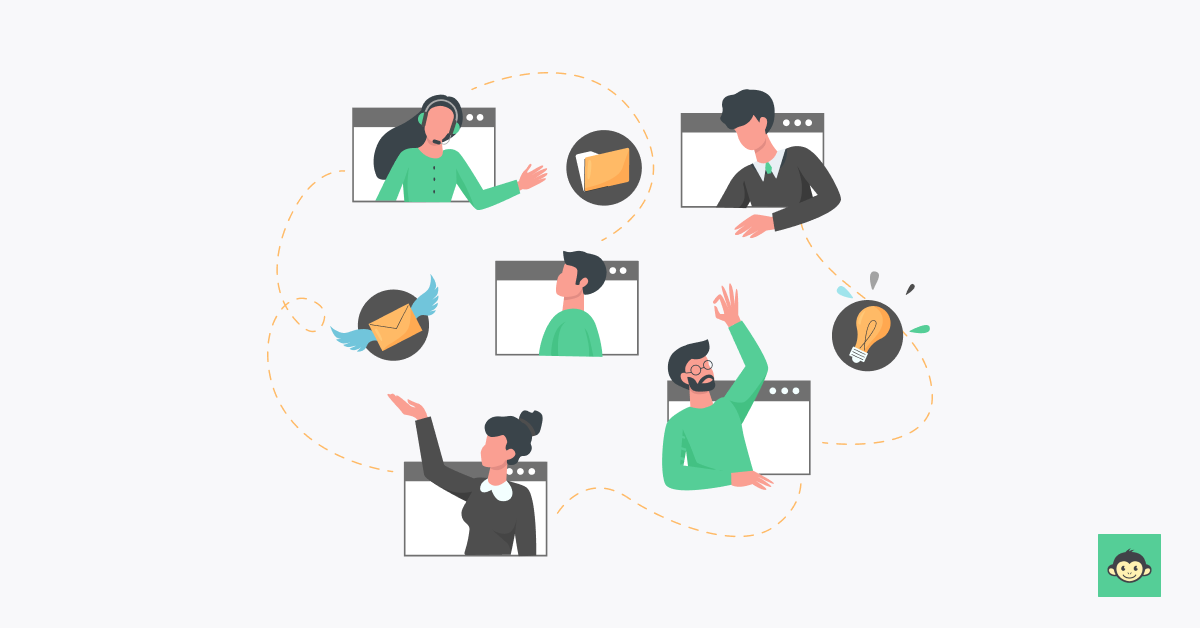
With so many options available, it's essential to know what features to look for to ensure your remote work experience is as productive and efficient as possible. Here are the top 8 essential features of remote work tools that can truly elevate your remote work game:
- Seamless communication: Effective communication is the lifeline of remote work. Look for tools that offer features like instant messaging, video conferencing, and voice calls. These functions ensure your team can connect effortlessly, regardless of physical distance.
- Collaborative workspaces: Remote work thrives on collaboration. Tools should provide a digital space where teams can work together in real-time, edit documents, and brainstorm ideas. Look for features like shared documents and collaborative whiteboards.
- Task and project management: Keeping track of tasks and projects is paramount. Look for tools that offer task lists, timelines, and the ability to assign tasks to team members. This feature ensures everyone knows their responsibilities and deadlines.
- File sharing and storage: Remote teams need easy access to documents and files. Ensure your tool has secure cloud storage, file-sharing capabilities, and version control to prevent data loss or confusion.
- Security and privacy: Data security is non-negotiable. Look for tools that offer robust security measures, like encryption, multi-factor authentication, reverification, and access controls. Protecting sensitive information is vital in a remote setting.
- Integration capabilities: No tool is an island. Look for options that integrate seamlessly with other software your team uses, such as email clients, calendar apps, and project management platforms. This simplifies workflows and minimizes the need to switch between multiple tools.
- Analytics and reporting: Data-driven decisions are key to success. Tools that provide analytics and reporting features can help you track productivity, measure project progress, and identify areas for improvement.
- Mobile accessibility: In today's world, work happens on the go. Ensure your chosen tool has a mobile app or is mobile-responsive, allowing you to stay connected and productive from your smartphone or tablet.
What are the different types of remote working tools?

Different types of remote working tools are the driving force behind successful and efficient virtual collaboration. Let's explore five key types of these tools and how they empower remote teams:
Employee feedback survey tools
Remote work can sometimes create a disconnect between employees and their organizations. Employee feedback survey tools bridge this gap by allowing companies to gather valuable insights from their remote workforce. These tools enable HR departments and managers to create surveys, questionnaires, and feedback forms that employees can easily access and complete online.
Communication tools
Imagine working remotely without the ability to talk to your team in real-time. Communication tools, like video conferencing, instant messaging, and VoIP services, bridge the gap. They enable face-to-face meetings, quick chats, and voice calls, ensuring that your team stays connected and collaboration flows effortlessly.
These tools are the heartbeat of remote work, allowing for seamless interaction no matter where you are.
Collaboration and project management tools
When you're miles apart, managing projects and collaborating on tasks can become a logistical nightmare. Collaboration and project management tools come to the rescue. They provide digital workspaces where teams can co-create, edit documents, share files, and track progress in real-time. These tools keep everyone on the same page and ensure that projects move forward smoothly.
File sharing and storage tools
In a remote work setup, you need a secure place to store and share documents. File sharing and storage tools offer cloud-based solutions that enable you to access your files from anywhere. They often come with features like version control and password protection, ensuring that your data is both accessible and safe.
Time and task management tools
Staying organized in a remote work environment is paramount. Time and task management tools help you schedule your day, set priorities, and track your progress. They often include features like to-do lists, calendars, and reminders, helping you stay on top of your workload and meet deadlines.
Security and data protection tools
With sensitive information being transmitted online, security is a top concern. Security and data protection tools safeguard your digital workspace. They include features like encryption, multi-factor authentication, and access controls, ensuring that your data remains confidential and protected from cyber threats.
30+ Remote work tools (Free and paid)
Employee feedback survey tools:
1. CultureMonkey (Paid)
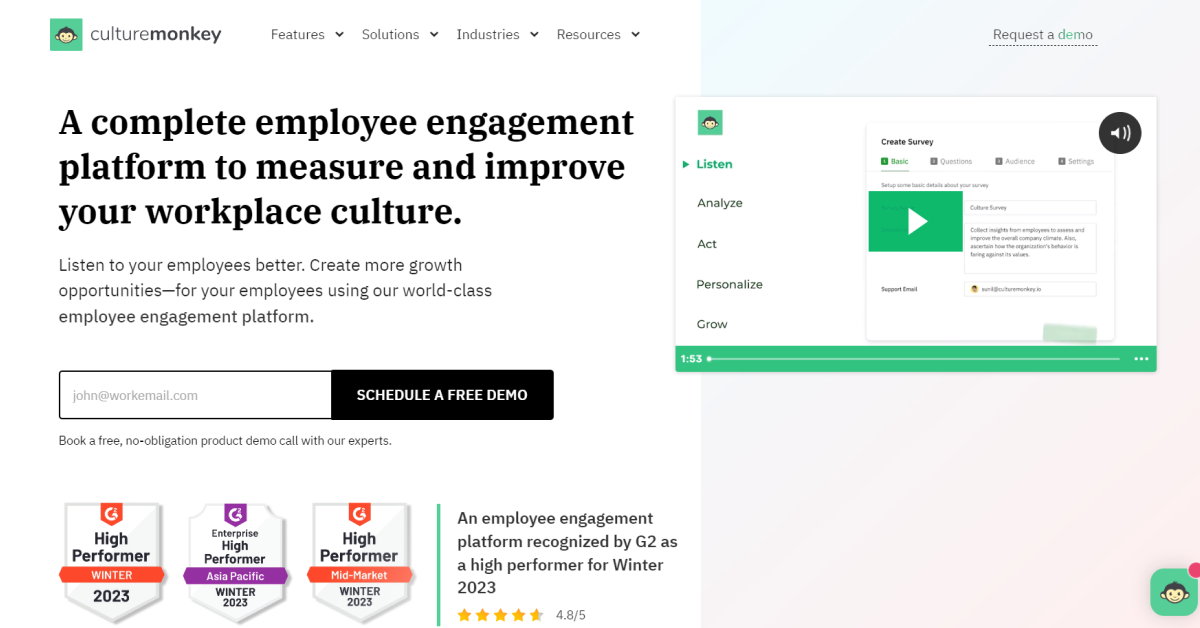
CultureMonkey is a robust HR tool designed to measure and enhance employee engagement throughout their lifecycle. It offers a comprehensive range of features that empower organizations to set, track, and analyze engagement goals.
With over 100 meticulously researched survey templates, CultureMonkey enables HR leaders to gain valuable insights into their workforce's sentiments and experiences.
One standout feature is the ability to send fully customizable, multi-lingual employee surveys. This functionality facilitates high participation rates from both blue-collar and white-collar employees, fostering a comprehensive understanding of workplace dynamics.
The employee lifecycle module ensures continuous listening from onboarding to separation, aiding in predicting attrition and taking proactive measures. Pulse surveys provide real-time feedback, offering a dynamic understanding of workplace culture and employee sentiments.
CultureMonkey's advanced engagement metrics assess 15+ drivers, encompassing work-life balance, mental health, leadership, recognition, and more. Powered by GPT technology, the platform swiftly processes extensive employee feedback, generating actionable engagement analytics for informed decision-making.
Prioritizing employee privacy and security, CultureMonkey is GDPR compliant, ensuring anonymous feedback collection, analytics, and reporting. Its seamless integration with various business tools, including Zoho People, Darwin Box, Keka HR, and Workday, adds flexibility and convenience to the engagement assessment process.
Learn more about CultureMonkey
2. SurveyMonkey (Paid)
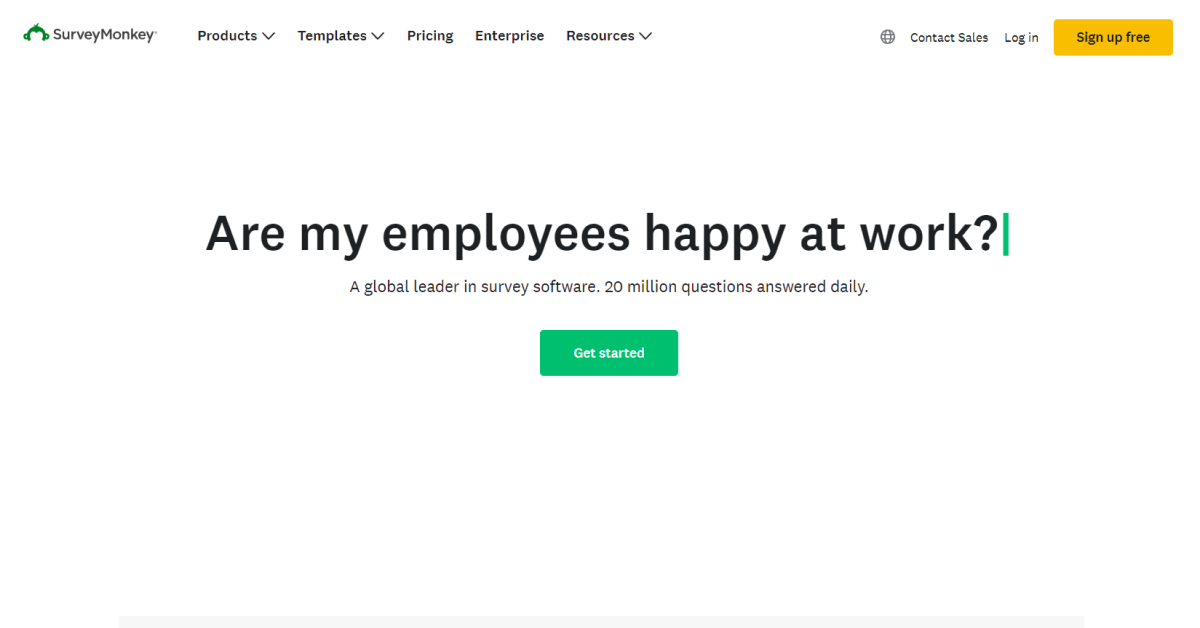
SurveyMonkey is a versatile employee feedback survey tool that empowers organizations to gather insights from remote employees. With its user-friendly interface and a wide range of survey templates, it enables HR professionals to create customized surveys tailored to remote work experiences.
Remote employees can easily participate in these surveys from anywhere, providing valuable feedback on their work environment, job satisfaction, and communication preferences. SurveyMonkey's analytics tools help businesses interpret the data and identify areas for improvement, making it a valuable tool for enhancing remote work experiences.
Learn more about SurveyMonkey
3. Qualtrics (Paid)
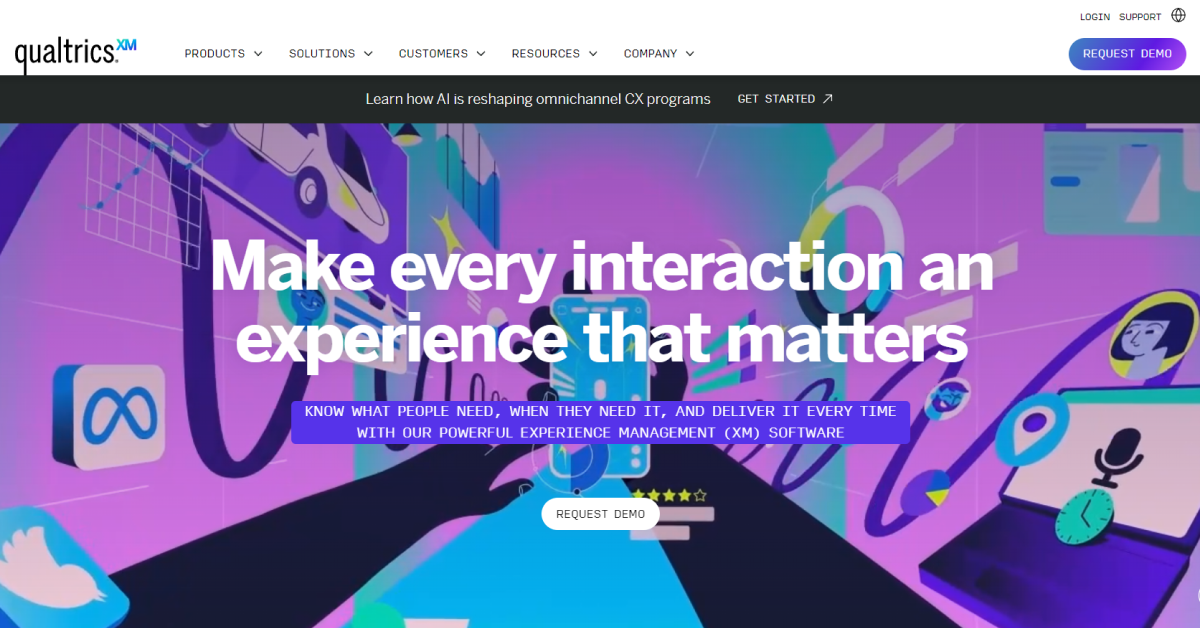
Qualtrics is a powerful feedback and experience management platform that goes beyond traditional surveys. It allows remote employees to provide feedback through various channels, including surveys, chat, and email. Confirmit vs Qualtrics is a common comparison when organizations evaluate tools for designing employee experience programs. Qualtrics, for instance, enables businesses to gather insights and take action to improve remote work conditions, offering a robust solution for employee engagement and satisfaction.
It also offers sentiment analysis tools, helping HR professionals understand the emotional well-being of remote employees. Qualtrics' real-time dashboards provide immediate feedback, allowing companies to make agile adjustments to enhance the remote work environment.
Learn more about Qualtrics
4. Officevibe (Free & paid)
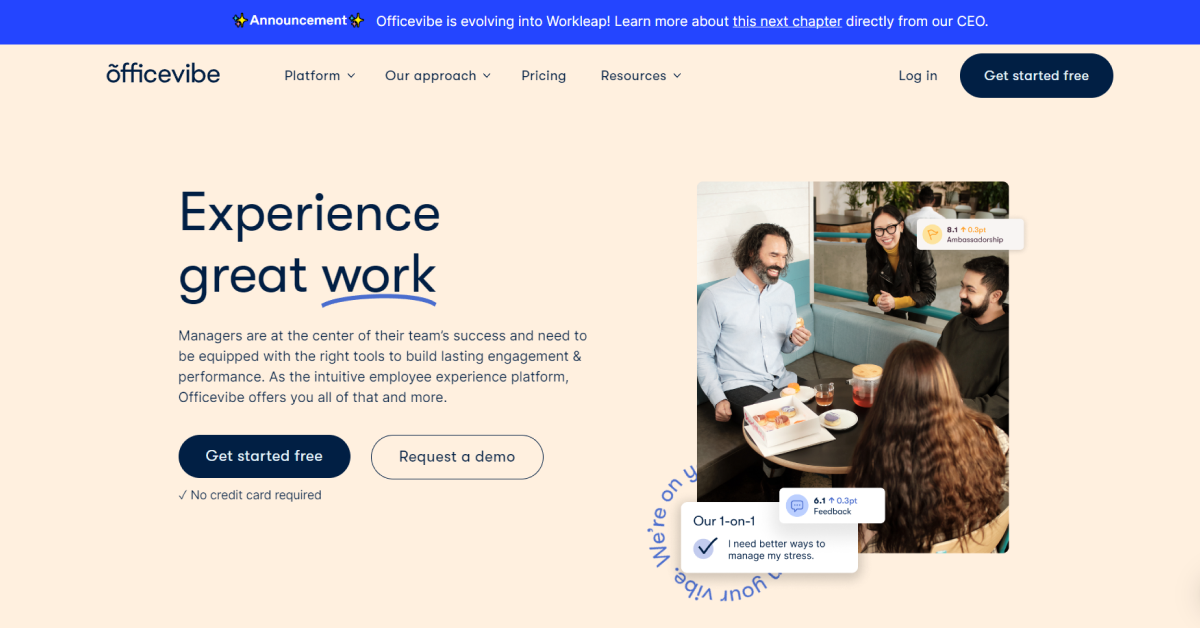
Officevibe is an employee feedback survey tool designed to improve workplace culture and employee engagement, even in remote settings. It enables remote employees to provide feedback through pulse surveys and anonymous comments. The tool focuses on key aspects such as communication, recognition, and personal growth.
Officevibe's reports and analytics help HR teams track remote employee satisfaction and identify trends. It also provides actionable insights and recommendations for improving the remote work experience, fostering a sense of belonging and connection among remote team members.
Learn more about Officevibe
5. TINYpulse (Paid)
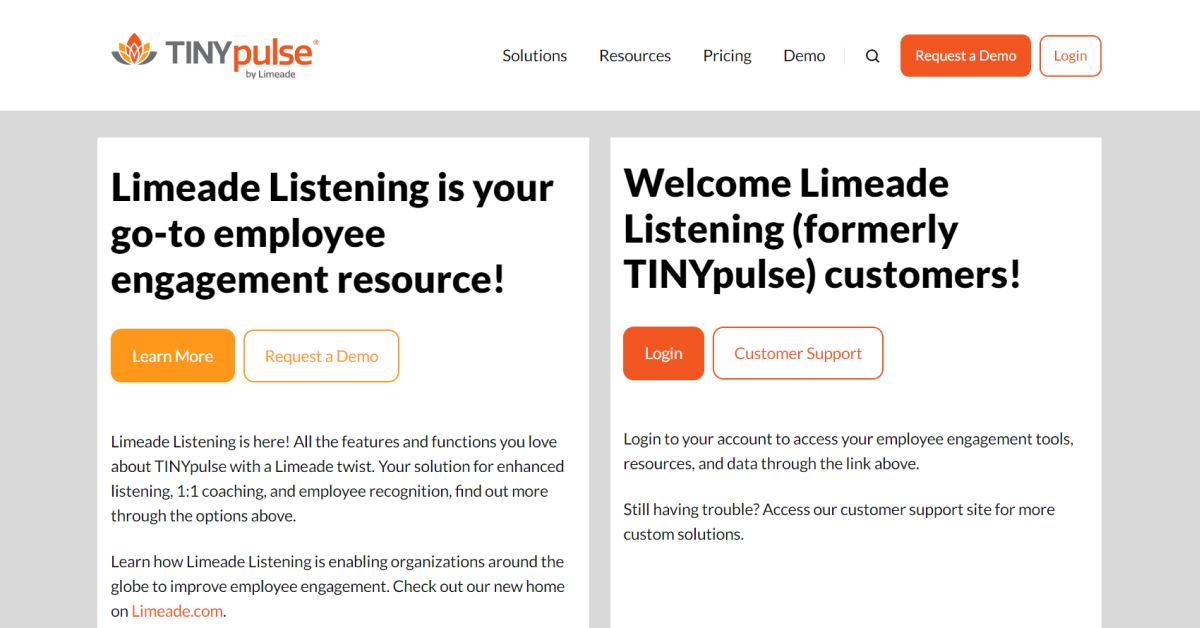
TINYpulse is a feedback and recognition platform that helps remote employees stay engaged and connected. It allows remote workers to provide feedback through regular pulse surveys, check-ins, and recognition shout-outs. TINYpulse's Cheers for Peers feature encourages remote team members to acknowledge and appreciate each other's contributions.
The platform's engagement analytics help organizations assess remote employee morale and sentiment. TINYpulse's anonymous feedback option ensures that remote employees feel comfortable sharing their thoughts and concerns, making it an effective tool for maintaining a positive remote work culture.
Learn more about TINYpulse
6. Zoho Survey (Free & paid)
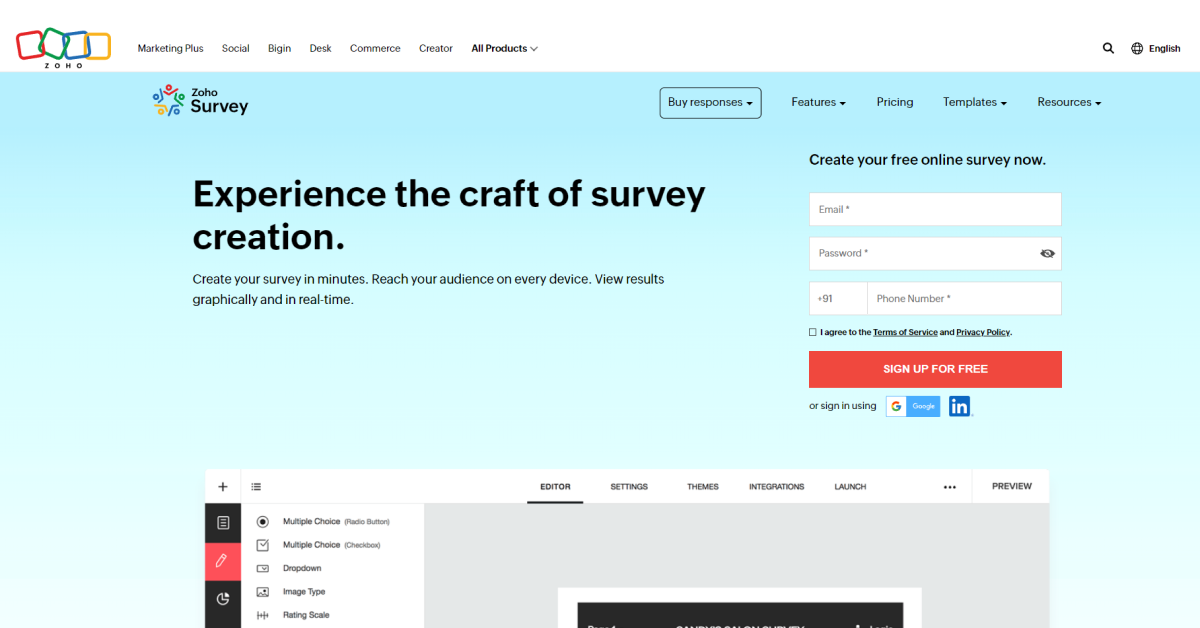
Zoho Survey is an employee feedback survey tool that plays a pivotal role in empowering remote workers and organizations to enhance employee engagement and satisfaction. It simplifies the process of gathering valuable insights from remote teams, fostering a positive work environment.
One of Zoho Survey's standout features is its intuitive survey creation interface, which allows remote HR professionals to design customized surveys tailored to remote work experiences. These surveys can be easily distributed to remote employees through email or shared links, ensuring participation and feedback collection from dispersed teams.
Learn more about Zoho Survey
Employee communication tools
7. Chanty
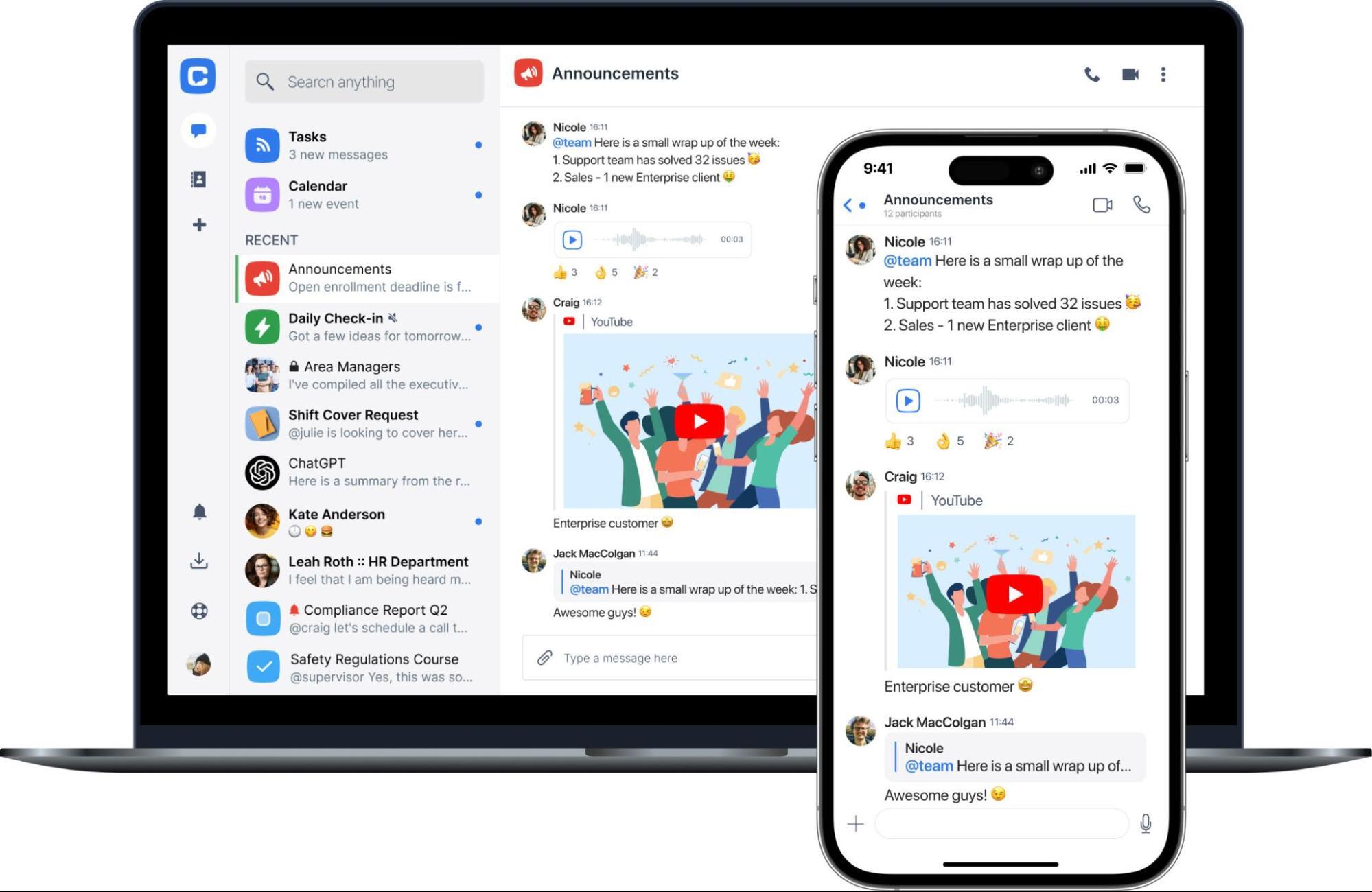
Chanty is an employee engagement platform that helps onsite and remote teams stay connected. Chanty allows unlimited messaging, audio/ video calls, task manager and file sharing in one workspace for better collaboration and keeping the team connected no matter where they work. For quicker communication send voice messages even on the go.
Chanty offers Surveys & Polls for gathering quick opinions, and it recently introduced Scheduled and Disappearing messages to keep conversations timely and secure.
Learn more about Chanty
8. Zoom (Free plan with limitations)

Zoom has become synonymous with virtual meetings and webinars, making it an essential communication tool for remote employees. Its user-friendly interface allows remote workers to connect seamlessly through video and audio calls, chat, and screen sharing. Zoom's breakout rooms feature enables remote teams to split into smaller groups for focused discussions or brainstorming sessions.
It also offers integration with other productivity tools, enhancing collaboration. For remote employees, Zoom helps bridge the distance by facilitating face-to-face communication, making it easier to build relationships, hold team meetings, and conduct training sessions, all without the need for a physical office.
Learn more about Zoom
9. Slack (Free plan with limitations)

Slack is a real-time messaging and collaboration platform that revolutionizes remote communication. It offers chat channels, direct messaging, file sharing, and integrations with various apps and services. Slack keeps remote teams connected and organized, providing a centralized hub for conversations and file sharing.
Its search functionality makes it easy to find past discussions and information, improving productivity and reducing information silos. Slack's versatility extends to voice and video calls, allowing remote employees to have quick, informal meetings when needed. For remote teams, Slack acts as a virtual water cooler, fostering camaraderie and facilitating project collaboration, all in one place.
Learn more about Slack
10. Microsoft Teams (Free plan with limitations)

Microsoft Teams is a comprehensive collaboration platform that integrates seamlessly with the Microsoft 365 suite of tools. It provides remote employees with chat, video conferencing, document sharing, and task management capabilities. Teams' channels keep conversations organized by project or department, making it easier for remote workers to find and reference information.
Its integration with Microsoft Office apps ensures a smooth workflow for document editing and collaboration. Teams also offers guest access, allowing external partners or clients to join discussions and collaborate, making it a valuable tool for remote employees working with external stakeholders.
Learn more about Microsoft Teams
11. Skype (Free plan with limitations)

Skype, a veteran in the world of online communication, remains a reliable choice for remote employees. It offers free video and voice calls, instant messaging, and screen sharing. Skype's accessibility on multiple devices ensures remote workers can stay connected from their preferred platform.
It's especially useful for one-on-one meetings and informal catch-ups, helping remote employees maintain a sense of connection and camaraderie despite the physical distance. Skype's simplicity and familiarity make it a valuable tool for remote teams looking for straightforward communication options.
Learn more about Skype
12. Discord (Free plan with limitations)

Originally designed for gamers, Discord has found its way into the business world as a communication tool for remote employees. It offers text, voice, and video communication in channels and direct messages. Discord's voice chat rooms, known as "voice channels," provide a dynamic space for discussions and collaboration. It's particularly popular among remote teams with a more casual or creative work culture.
Discord's features, like screen sharing and integrations with other productivity tools, enhance remote team communication and collaboration. For remote employees who appreciate a more relaxed and community-oriented communication style, Discord offers a unique and engaging platform.
Learn more about Discord
13. Nextiva (Free trial & paid plans)
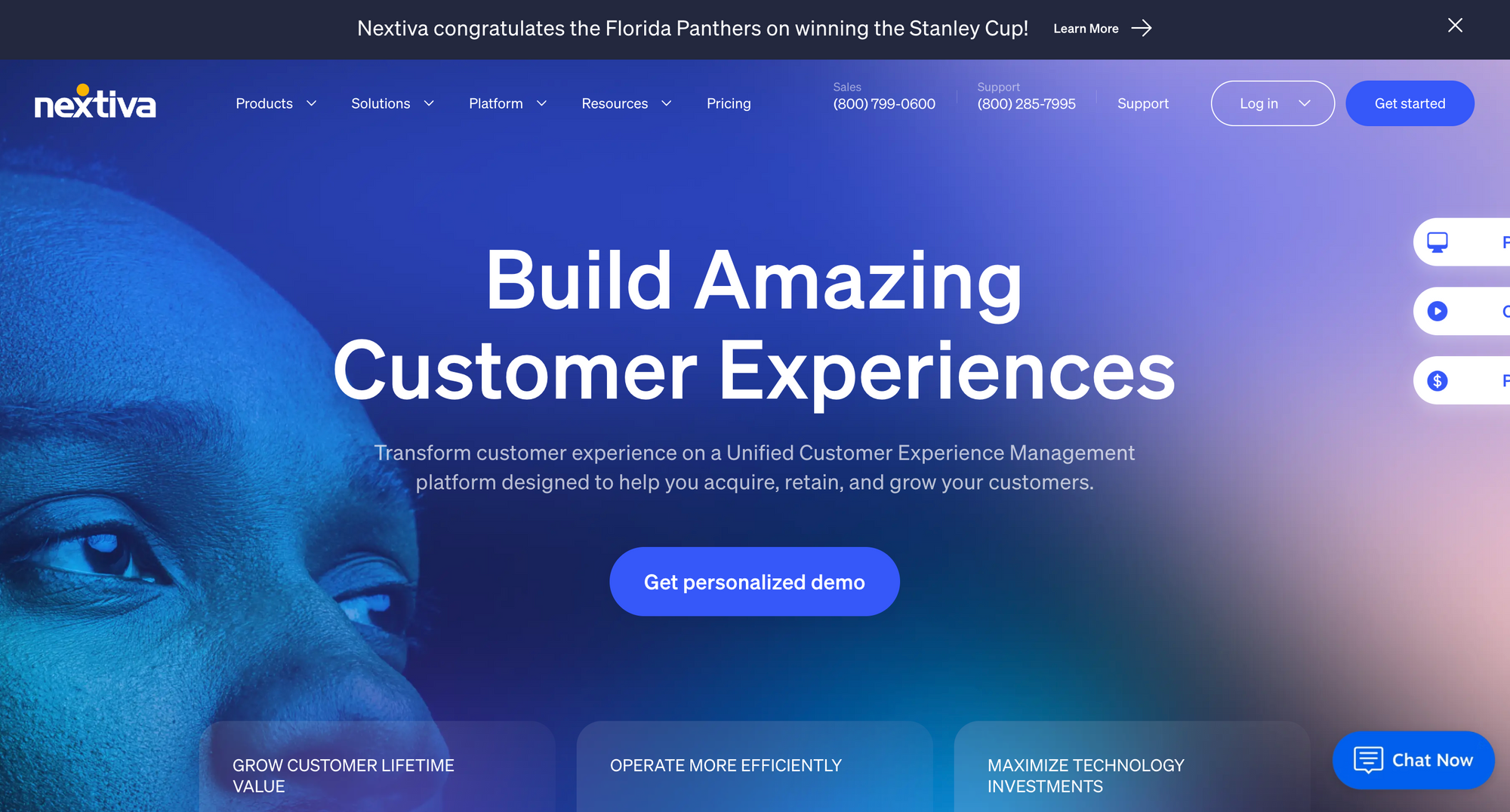
Nextiva is an all-in-one cloud communication platform built for businesses that need to stay connected across calls, video, chat, and SMS—whether in-office, remote, or hybrid. It’s designed to streamline internal communication and enhance the customer experience through unified tools and smart automation.
Nextiva provides high-quality VoIP phone systems, video conferencing, team messaging, and an intuitive app (NextivaONE) that keeps everything synced across devices. Its conversational AI features include advanced call routing, intelligent IVR, and voice recognition, helping teams deliver faster and more accurate customer support.
The platform centralizes all customer communication channels into a single inbox—including email, chat, SMS, and social—so teams never miss a message. With built-in analytics and reporting, companies can track performance, monitor team response times, and optimize workflows.
For businesses that value reliability, Nextiva offers 99.999% uptime, enterprise-level security (SOC 2, ISO 27001, GDPR-compliance), and scalable setup that grows with your team.
Learn more about Nextiva
Collaboration and project management tools
14. ProofHub

ProofHub is a project management and collaboration software that offers a digital workspace for remote teams of any size to organize their work efficiently. It centralizes all your projects, tasks, and related communication into one platform.
Teams can plan projects using Gantt charts, create task lists, track progress with Kanban boards, and collaborate through features like discussion boards, in-built chat, file sharing, proofing & approvals, and more. Additionally, ProofHub offers a flat pricing model with no per-user fee, making it easier to scale your remote workforce without worrying about per-user costs.
Learn more about Proofhub.com
15. Trello (Free plan with limitations)

Trello is a versatile project management tool that helps remote employees stay organized and collaborate effectively. Its user-friendly interface offers boards, lists, and cards that represent tasks and projects. Remote teams can create customized workflows, assign tasks, set due dates, and attach files to cards.
Trello's visual layout makes it easy to track progress and prioritize work. For remote employees, Trello provides a centralized space for project management, promoting transparency and accountability. Its mobile app ensures accessibility from anywhere, helping remote workers stay connected to their tasks and team members.
Learn more about Trello
16. Asana (Free plan with limitations)

Asana is a robust project management platform that empowers remote employees to plan, execute, and track projects efficiently. It offers task lists, timelines, and dependencies, enabling remote teams to visualize project workflows and deadlines. Asana's collaboration features include task assignments, comments, and file attachments.
Remote employees can easily communicate and collaborate within the platform, reducing the need for lengthy email threads. Asana's reporting and analytics provide insights into project progress and team performance, facilitating informed decision-making. Its integrations with various productivity tools enhance remote team efficiency, making it a valuable asset for remote project management.
Learn more about Asana
17. Monday.com (Paid)

Monday.com is a highly customizable work operating system that streamlines remote team collaboration and project management. It provides remote employees with visual boards, timelines, and charts to plan, track, and execute projects. Users can create custom workflows, automate repetitive tasks, and set up notifications for updates.
Monday.com's integrations with popular tools like Slack and Zoom enhance remote communication and collaboration. For remote teams, Monday.com offers a centralized platform where they can manage projects, assign tasks, and monitor progress. Its flexibility and adaptability make it suitable for various remote work scenarios and industries, helping teams stay connected and productive.
Learn more about Monday.com
18. Psono (Free plan with limitations)
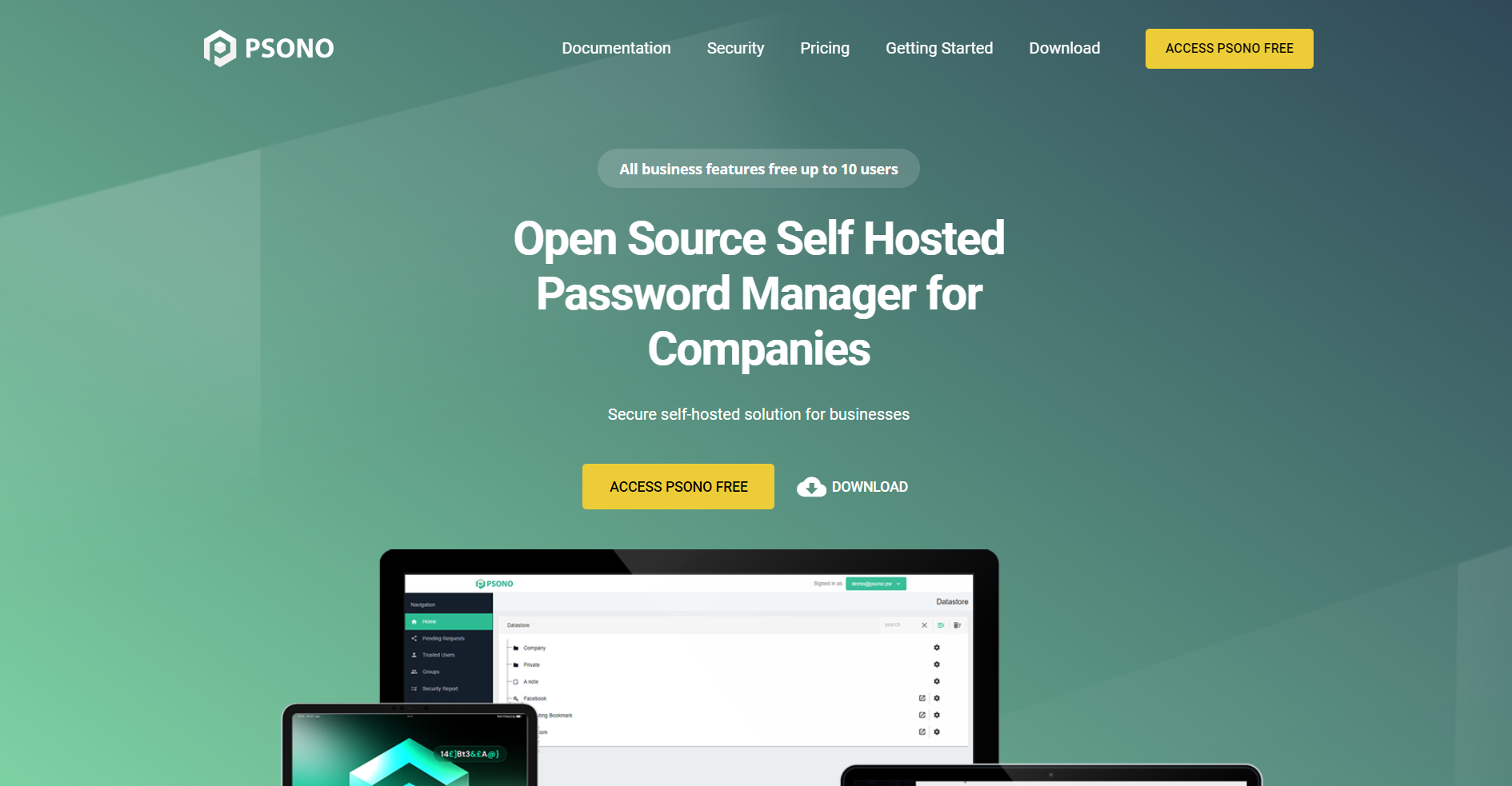
Psono stands out as a versatile open source password manager, ideal for remote teams looking for secure and efficient ways to manage their credentials. The platform supports a wide range of authentication methods, including TOTP, FIDO2, and WebAuthn, ensuring that users have multiple options for secure access.
Psono's emphasis on security extends to its zero-knowledge architecture, meaning that even the service providers cannot access your stored passwords. This feature, combined with an intuitive user interface, makes Psono a reliable choice for teams needing to safeguard sensitive information across various devices and locations.
Psono's ability to integrate with existing workflows through its API and its compatibility with various platforms, such as mobile and desktop, make it a seamless addition to any remote work setup. Whether you're a small team or a large enterprise, Psono provides the flexibility and security necessary to keep your digital workspace protected and efficient.
Learn more about Psono
19. Basecamp (Paid)

Basecamp is a project management and team collaboration tool designed to simplify remote work. It offers to-do lists, message boards, schedules, and document storage. Remote employees can use it to centralize communication, track tasks, and share project-related files. Basecamp's message board feature acts as a virtual workspace for team discussions and announcements, reducing the need for scattered email threads.
It also includes document storage and a document editor, promoting collaborative document creation. Basecamp's straightforward interface and focus on simplicity make it an ideal choice for remote teams looking to streamline communication and project management in one place.
Learn more about Basecamp
20. Jira - Atlassian (Paid)
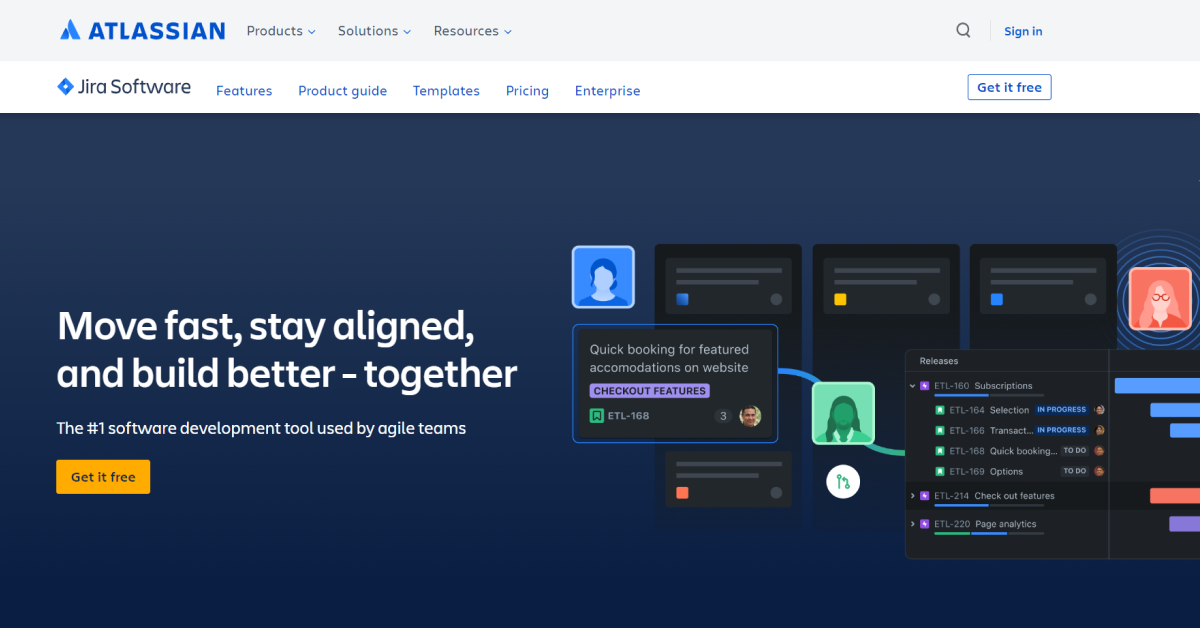
Jira, developed by Atlassian, is a comprehensive project management and issue tracking tool often used for software development but adaptable to various project types. It offers remote employees agile project management, customizable workflows, and detailed issue tracking. Jira enables remote teams to plan sprints, manage backlogs, and visualize progress through scrum and kanban boards.
Its integrations with other Atlassian tools like Confluence and Bitbucket enhance collaboration within the development lifecycle. Jira's reporting and analytics provide remote teams with insights into project performance and bottlenecks, enabling data-driven decision-making. Teams can also export Jira to Excel for custom reporting. It's a versatile tool for remote employees, especially those working on complex projects that require meticulous tracking and issue management.
Learn more about Jira
21. Google Hangouts (Free if you have a Gmail)

Google Hangouts is a versatile communication tool that doubles as a collaboration platform, significantly aiding remote workers in their quest for seamless teamwork. Although primarily known for its video conferencing capabilities, Hangouts packs several features that enhance remote collaboration.
Its integration with other Google Workspace apps, such as Google Docs, Sheets, and Slides, takes collaboration to the next level. Multiple team members can work on the same document simultaneously, enabling real-time edits and feedback. This collaborative workspace ensures that remote workers can collectively brainstorm ideas, make data-driven decisions, and track project progress effortlessly.
Learn more about Google Hangouts
File sharing and storage tools
22. Dropbox (Free plan with limitations)

Dropbox is a popular cloud-based file-sharing and storage tool that plays a vital role in the remote work landscape. It allows remote employees to store files in the cloud, making them accessible from any device with an internet connection. With features like file syncing, collaboration on documents, and sharing links, Dropbox ensures seamless access to important files and promotes efficient collaboration among remote teams.
Its version history feature helps users recover previous file versions and track changes, which is especially valuable for collaborative projects. For remote employees, Dropbox serves as a reliable repository for documents, presentations, and other work materials, enhancing productivity and ensuring that critical files are always at their fingertips.
Learn more about Dropbox
23. Google Drive (Free plan with limitations)

Google Drive is a versatile cloud storage and collaboration platform that empowers remote employees to create, store, and share documents, spreadsheets, presentations, and more. It integrates seamlessly with other Google Workspace tools like Google Docs, Sheets, and Slides, allowing real-time collaboration on documents. Remote workers can access files from any device and work offline, syncing changes when reconnected.
Google Drive simplifies file sharing through links and permissions settings, making it easy to collaborate with team members or external partners. Its search functionality and organizational features enhance file management, ensuring that remote employees can quickly locate and work on the documents they need. For remote teams, Google Drive fosters collaboration and document management in a user-friendly and accessible platform.
Learn more about Google Drive
24. Box (Free plan with limitations)

Box is a secure and scalable cloud content management platform designed to enhance remote collaboration and data security. It offers remote employees a centralized location for storing, sharing, and collaborating on files. Box's robust security features, including encryption, access controls, and compliance tools, ensure that sensitive data remains protected.
Its real-time collaboration features, such as document co-editing and commenting, facilitate seamless teamwork among remote colleagues. Box's integrations with productivity tools like Microsoft Office and Google Workspace enhance remote work capabilities. For remote employees, Box provides a secure and efficient file-sharing and storage solution, enabling them to work confidently and collaboratively while maintaining control over data access and permissions.
Learn more about Box
25. OneDrive (Free plan with limitations)

OneDrive is Microsoft's cloud storage and file-sharing solution that seamlessly integrates with the Microsoft 365 suite of productivity tools. Remote employees can store and access files from anywhere using OneDrive, ensuring flexibility and accessibility. Its real-time co-authoring feature simplifies collaborative document editing, making it an ideal choice for remote teams working on reports, presentations, and spreadsheets.
OneDrive's version history and file recovery options help remote employees track changes and restore previous file versions when needed. Additionally, its cross-platform compatibility ensures remote workers can access their files on various devices and operating systems. For remote teams, OneDrive offers a cohesive and familiar file-sharing and storage experience, aligning seamlessly with other Microsoft 365 apps and services to enhance remote work productivity.
Learn more about OneDrive
26. iCloud (Free plan with limitations)

iCloud is Apple's cloud storage and file-sharing service, primarily catering to users within the Apple ecosystem. Remote employees using Apple devices benefit from iCloud's seamless integration, allowing them to store files, photos, and documents securely in the cloud. iCloud Drive enables file access across macOS, iOS, and Windows devices, promoting flexibility for remote workers.
Sharing files with colleagues is simplified through iCloud's sharing links and collaboration features, making it easier to work on projects together. iCloud also provides automatic backup and synchronization for photos and files, ensuring data consistency across devices. For remote employees using Apple devices, iCloud serves as a convenient and reliable cloud storage solution, seamlessly connecting their work and personal files while maintaining data security and accessibility.
Learn more about iCloud
Time and task management tools
27. Todoist (Free plan with limitations)

Todoist is a versatile task management tool that empowers remote employees to organize their work efficiently. It offers a straightforward interface for creating to-do lists, setting priorities, and due dates. Remote workers can categorize tasks into projects and subtasks, helping them maintain clarity amidst their workload. Todoist's cross-platform compatibility ensures accessibility from various devices, enabling remote employees to manage tasks on the go. This flexibility is particularly beneficial for those using iPhones, as the built-in voice to text feature streamlines the task creation process.
Its collaboration features, such as task sharing and comments, facilitate teamwork even in dispersed teams. For remote employees, Todoist simplifies task management, aiding in prioritization and time allocation, ultimately enhancing productivity and focus.
Learn more about Todoist
28. Toggl (Free plan with limitations)
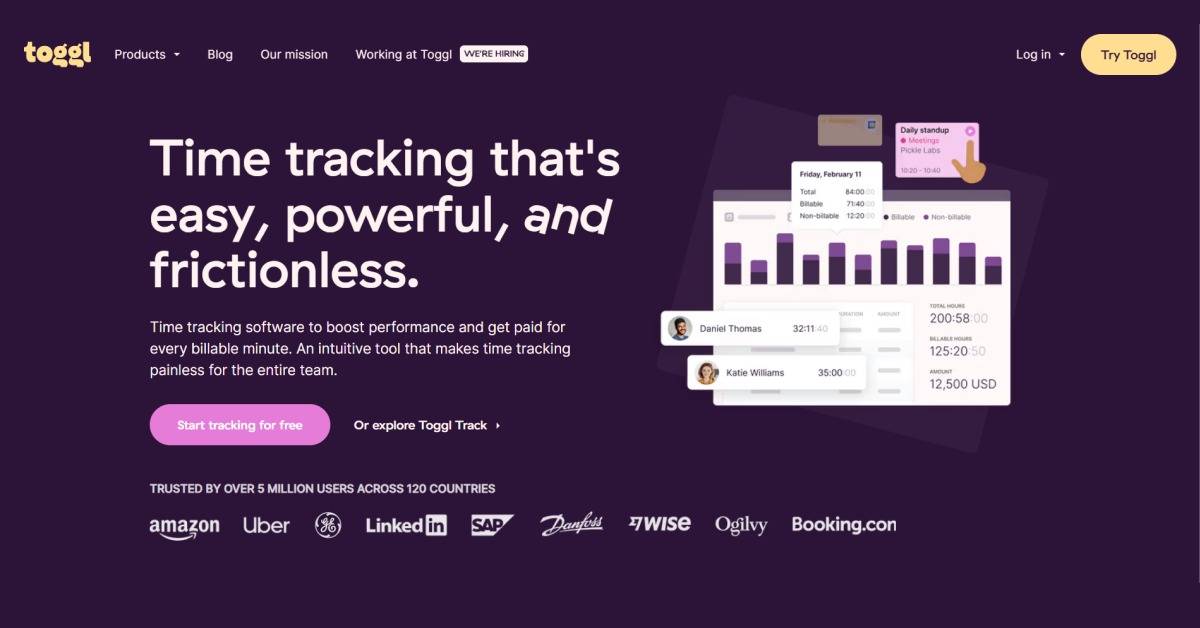
Toggl is a time-tracking and productivity tool designed to help remote employees manage their time effectively. It offers remote workers the ability to track the time spent on tasks and projects accurately. Toggl's visual time entries and project categorization provide insights into where time is allocated, helping users identify areas for improvement.
Remote employees can generate detailed reports and share them with colleagues or supervisors for better project planning and resource allocation. Toggl's integrations with task management tools enhance the synergy between tracking time and managing tasks. For remote teams, Toggl ensures accountability, transparency, and productivity by enabling them to monitor and optimize time usage.
Learn more about Toggl
29. ClickUp (Paid)
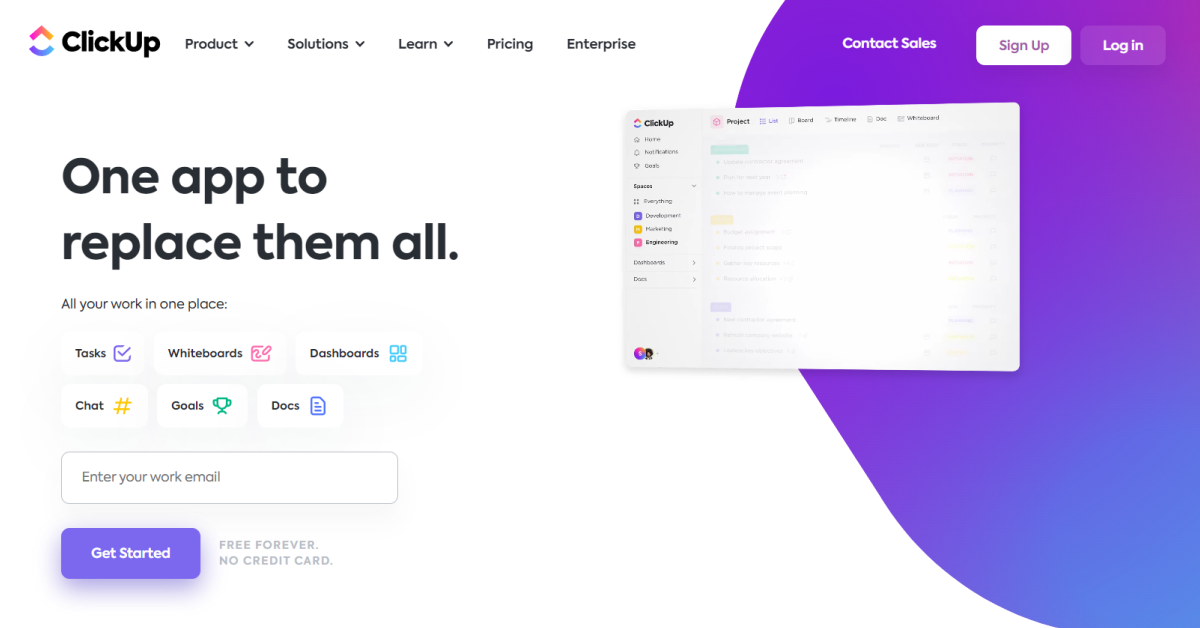
ClickUp is a comprehensive project management and productivity tool designed to streamline remote work processes. It offers remote employees features for task management, goal tracking, and time management. ClickUp's customizable dashboards enable users to tailor their workspace to their specific needs, promoting organization and efficiency. The platform's time tracking capabilities allow remote workers to monitor the time spent on tasks, projects, or clients accurately.
ClickUp's collaboration features, including comments and shared documents, facilitate teamwork and communication among remote teams. With its integrations and automation, ClickUp simplifies complex workflows and enhances remote work productivity. For remote employees, ClickUp serves as an all-in-one solution for managing tasks, time, and projects, making it easier to stay organized and focused.
Learn more about ClickUp
30. Wrike (Free plan with limitations)
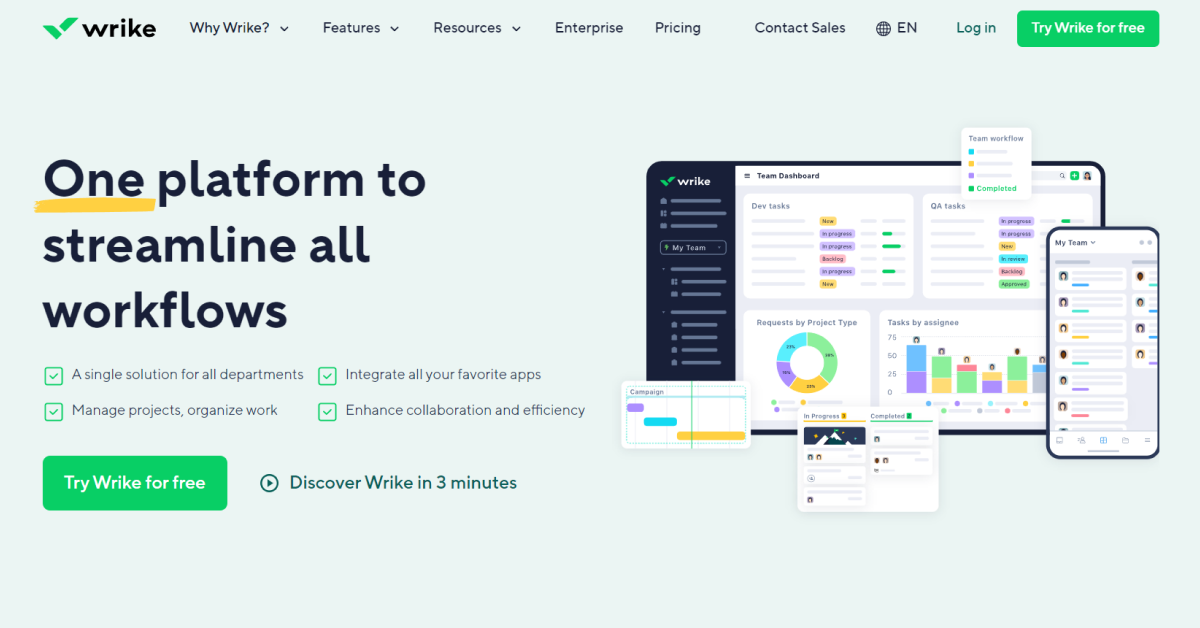
Wrike is a versatile work management and collaboration platform tailored to remote employees. It offers remote teams features for task management, project planning, and resource allocation. Wrike's interactive Gantt charts provide a visual representation of project timelines, helping remote workers track progress and identify dependencies. Its task delegation and workflow automation streamline project processes, enhancing productivity.
Wrike's real-time collaboration capabilities, such as @mentions and document sharing, ensure seamless communication among remote teams. With its reporting and analytics, Wrike provides insights into project performance and resource utilization, enabling informed decision-making. For remote employees, Wrike centralizes project management, fostering collaboration, transparency, and efficiency in remote work scenarios.
Learn more about Wrike
31. Notion (Free plan with limitations)

Notion is a versatile all-in-one workspace that caters to remote employees' task and project management needs. It offers features for note-taking, task lists, databases, and document collaboration. Notion's flexible templates and database functionality allow remote workers to create customized workflows and project dashboards. It integrates seamlessly with popular sales productivity tools and offers a mobile app for on-the-go access.
Notion's real-time collaboration and commenting features enable remote teams to collaborate efficiently on documents, tasks, and projects. Its cross-functional capabilities make it adaptable to various remote work scenarios, from managing personal tasks to collaborating on team projects.
Learn more about Notion
Security and data protection tools
32. LastPass (Free plan with limitations)

LastPass is a top-notch password management tool that provides remote employees with a secure and convenient way to manage their passwords. It allows users to store complex and unique passwords for various accounts in one encrypted vault. Remote workers can access their passwords across devices and browsers, eliminating the need to remember multiple login credentials.
With features like password generation and auto-fill, LastPass simplifies the login process, saving time and reducing the risk of password-related security breaches. It also enhances security with multi-factor authentication (MFA) options, ensuring that only authorized users can access sensitive accounts. LastPass is a valuable asset for remote employees, helping them maintain robust cybersecurity practices in an increasingly digital world.
Learn more about LastPass
33. Bitdefender (Paid)

Bitdefender is a comprehensive cybersecurity solution that empowers remote employees to protect their devices and data from a wide range of online threats. Its antivirus and anti-malware capabilities safeguard remote workers against viruses, ransomware, and other malicious software. Bitdefender's firewall and network protection features prevent unauthorized access and secure online transactions.
For remote workers, Bitdefender offers peace of mind, ensuring that their devices are shielded from cyberattacks and data breaches, allowing them to work confidently and securely from any location.
Learn more about Bitdefender
34. NordVPN (Free plan with limitations)

NordVPN is a virtual private network (VPN) service that plays a crucial role in ensuring the online privacy and security of remote employees. By encrypting internet traffic and masking IP addresses, NordVPN shields remote workers from potential online threats and surveillance. It's particularly useful when remote employees access public Wi-Fi networks, as it creates a secure tunnel for data transmission.
As an international VPN, NordVPN offers a global network of servers, making it a versatile solution for users who need secure access across different countries. It enables access to geo-restricted content, making it easier for remote employees to work with international clients or access resources from different regions. It empowers remote workers to browse the web, communicate, and conduct business with confidence, knowing that their online activities are protected and their data remains private.
Learn more about NordVPN
35. Duo Security (Paid)
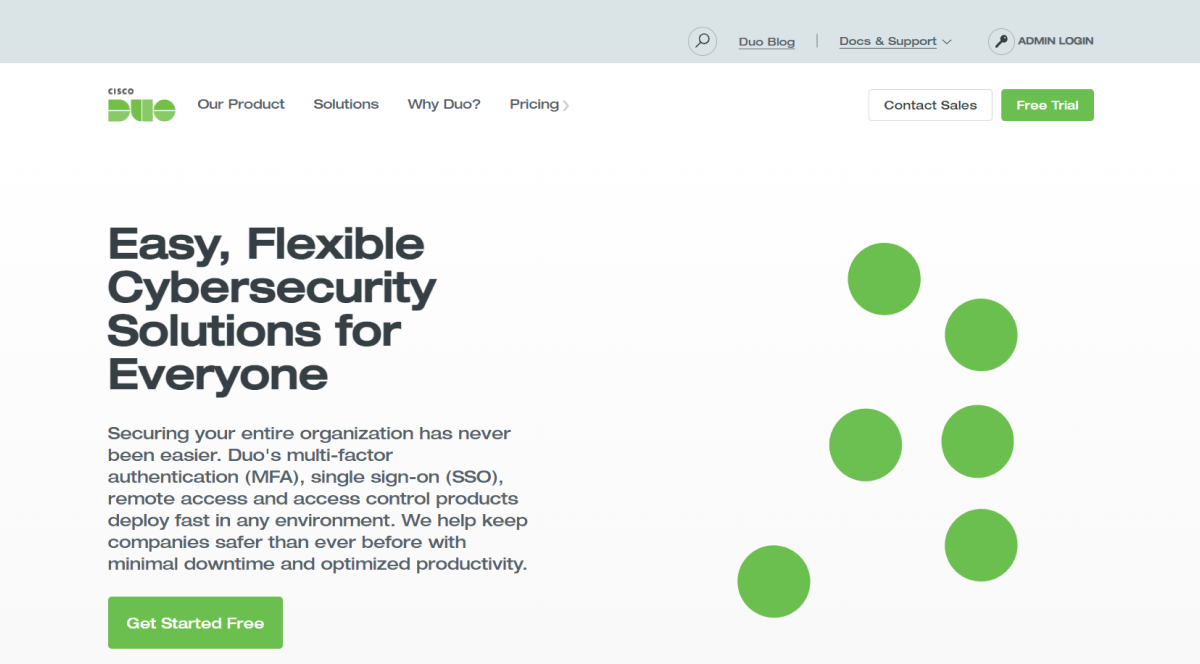
Duo Security provides remote employees with a robust multi-factor authentication (MFA) solution, enhancing access security for various applications and systems. It requires users to verify their identity through multiple authentication methods, such as a mobile app, SMS, or hardware token, in addition to their password.
This extra layer of security safeguards remote workers' accounts from unauthorized access, reducing the risk of data breaches due to compromised credentials. Duo Security's real-time access monitoring and policy enforcement ensure that remote employees can securely access company resources from anywhere, making it an essential tool for protecting sensitive data in remote work scenarios.
Learn more about Due Security
36. Varonis (Paid)
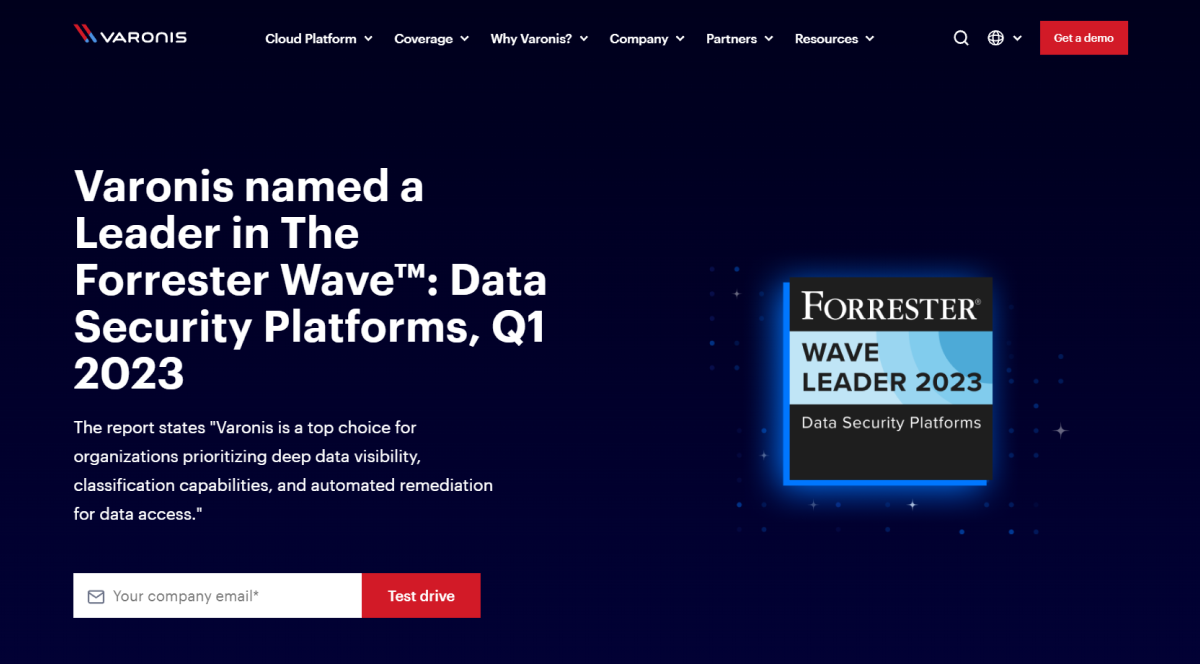
Varonis is a comprehensive data security and analytics platform that helps organizations and remote employees monitor, protect, and manage their data effectively. It offers real-time threat detection, data classification, and auditing capabilities. For remote employees, Varonis ensures that sensitive data is safeguarded, and unauthorized access is detected and prevented.
Its data-centric security approach aligns with the needs of remote work, where data is often accessed from various locations and devices. Varonis empowers remote workers to collaborate securely while maintaining control and visibility over their organization's critical data, ultimately enhancing data protection and compliance in remote work environments.
Learn more about Varonis
Bonus tool
37. Veed.io (Free plan with limitations)

Veed.io is a versatile online video editing platform that proves to be a game-changer for remote workers in the digital age. It empowers remote employees to create, edit, and enhance video content seamlessly, regardless of their location or level of expertise in video editing.
One of Veed.io's standout features is its user-friendly interface, which makes video editing accessible to everyone, even those without prior editing experience. Remote workers can easily trim, cut, merge, include music and add subtitles to video, all within the platform. This simplicity is invaluable for remote teams looking to create engaging video content for presentations, marketing campaigns, or training materials. With the addition of VEED's AI video generator, creating videos becomes even more streamlined, allowing remote teams to produce high-quality content effortlessly.
Conclusion
In the ever-evolving landscape of remote work, the right tools can be your trusty sidekicks, ensuring that you and your team soar to new heights of productivity and job satisfaction. We've explored an array of remote work tools that facilitate communication, collaboration, project management, file sharing, and time management, each playing a crucial role in making remote work not just viable but thriving.
But, before we wrap up this journey into the world of remote working software, let me introduce you to a real game-changer – CultureMonkey. When it comes to employee engagement and feedback surveys, CultureMonkey stands head and shoulders above the rest.
With its user-friendly interface, diverse survey templates, and advanced analytics, CultureMonkey empowers organizations to understand and enhance employee engagement throughout the entire employee lifecycle.
The platform's continuous listening approach ensures that your remote team's voices are heard, from onboarding to separation. Real-time feedback, in-depth engagement metrics, and secure, GDPR-compliant data handling make it a valuable asset for remote work environments.



